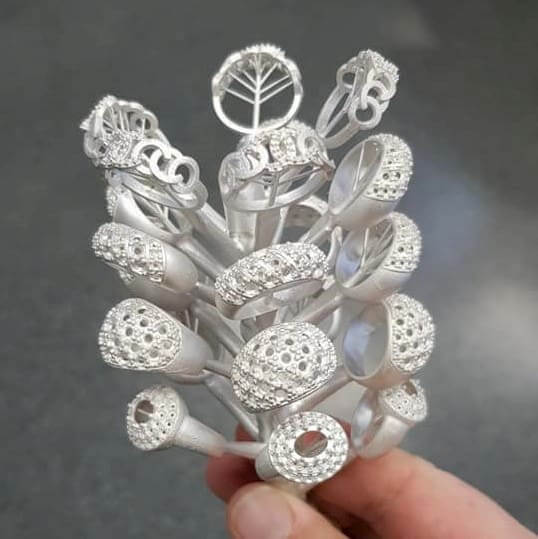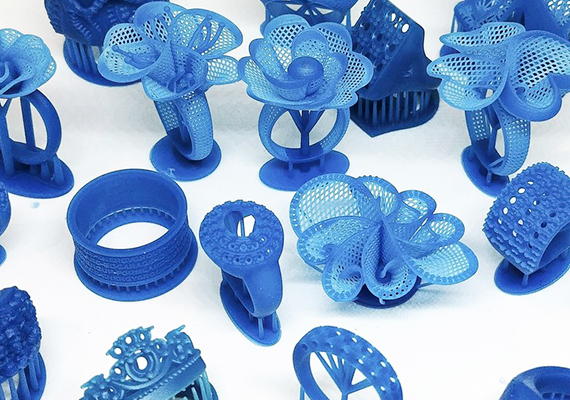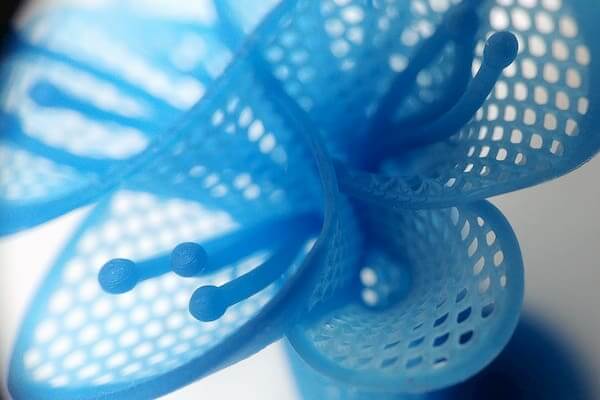3D printed jewelry: how does it work?
Special-purpose resins for jewelry casting
Resin 3D printers are more and more commonly used in jewelry casting due to their superior precision and speed.
Instead of manually sculpting investment patterns in castable wax, modern jewelers usually start with a drawing and then, based on their drawing, they make a CAD design.
A digital model of a jewelry piece is then sent to a 3D printer and fabricated automatically with special-purpose, castable resin. With 3D printed jewelry it is possible to get more repeatable results and significantly reduce human error. The entire process becomes digitized and more efficient.

How do castable resins work?
Castable resins are photopolymers designed to be functional equivalents of wax. Heated to temperatures reaching well over 750°C, they burn out, leaving ash residue not exceeding 0.003% of the pattern’s mass.
In a jewelry casting process, investment patterns printed with such resins are covered with investment material, which typically consists of water and gypsum mixed in exactly the right proportions.
A pattern covered with investment is called a flask, which is then put in the oven and heated to a certain temperature that the manufacturer recommends.
What matters most at this stage is the resin’s rate of thermal expansion; it should be kept as low as possible. Otherwise, an expanding resin could bloat out the investment and thus distort the desired dimensions of the model.
In the oven, a castable resin burns out in the investment and flows out of it, leaving space for target materials like gold or silver.
Once the target material poured into the investment has cooled down enough to become solid, the surrounding gypsum is broken down to retrieve the casted jewelry piece.

What makes a good castable resin?
According to Stefano Reale, a 3D printing specialist working at BlueCast, one of the leading European manufacturers of resins aimed at the jewelry market, the ability to work in a traditional process is one of the most important features of a successful jewelry resin.
Jewelers often care deeply about their long-standing traditions and tend to meet revolutionary changes with reluctance. This is why BlueCast resins are designed to be functional equivalents of wax, which means they can be used in a traditional casting process.
The only thing that really changes from the jeweler’s standpoint is that they no longer need to shape wax patterns by hand. It is not necessary to buy and learn how to use new equipment or switch to drastically different workflows. Moreover, Reale is adamant that there is no such thing as a castable resin that works well in all applications.
Types of castable resins
Choosing the right castable resin mostly depends on the design of the jewelry piece we want to cast. The resin should be optimized for a particular style in jewelry. BlueCast offers a range of castable resins roughly corresponding to styles in jewelry design dominant in different parts of the world.
The BlueCast X5 is a resin made for European-style jewelry with relatively small engagement rings, earrings, and chaton settings.

The BlueCast X10 is aimed at the American market, where jewelry generally tends to be less detailed and more bulky. Due to consistently smooth surfaces and high dimensional accuracy, the X10 is also good for casting larger designs out of silver.

For light, filigree shapes typically encountered in the Middle-Eastern style jewelry, BlueCast offers the LS 23 resin, which provides high printing accuracy for very fine details. Also, once printed, it can be re-shaped by hand to achieve even more elaborate designs.
Resin 3D printer for jewelry casting
Most castable resins come in variants that are optimized for two leading resin 3D printing technologies: laser SLA and UV LCD. Choosing one of the two usually comes down to personal preference, but for jewelry casting, LCD-based machines like the Zortrax Inkspire tend to have a slight edge over their SLA-based competitors.
This is because the diameter of the laser dot used in the most popular SLA machines is a bit too large to accurately draw very fine details that are especially present in Middle-Eastern jewelry designs.
LCD 3D printers are also a bit faster because the entire layer is solidified all at once, which matters in larger jewelry workshops seeking to increase their output by printing multiple models in one go.
 English
English  Français
Français
